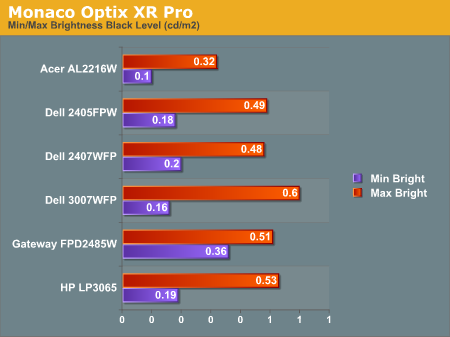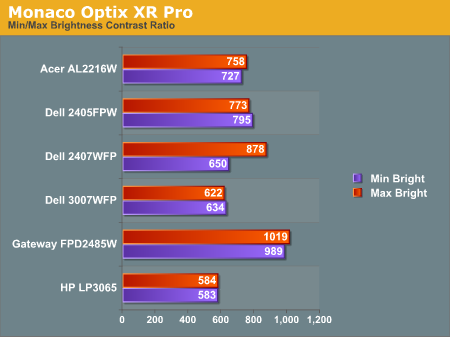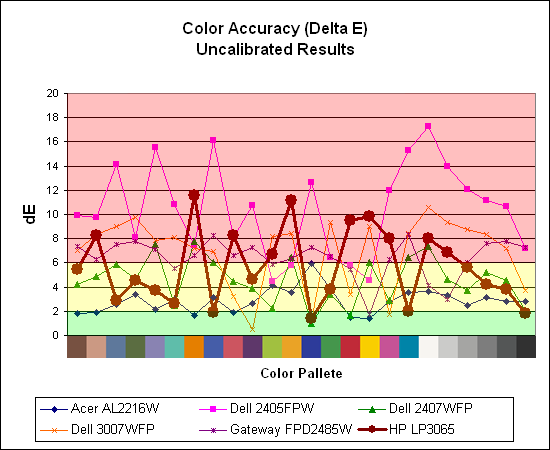HP LP3065: A new contender for the 30" throne
by Jarred Walton on March 22, 2007 7:00 AM EST- Posted in
- Displays
Uncalibrated Results
Brightness and Contrast Ratio
For these tests more than any others, we depend on the hardware colorimeter and software to help calibrate the displays. As previously stated, we use a Monaco Optix XR (DTP-94) colorimeter and Monaco Optix XR Pro software. The software and hardware are relatively easy to use and help users to get more accurate color from their displays. Before we get to the calibrated results, we took a quick look at how the displays performed at maximum brightness as well as how they fared without any color profile. We used the default contrast and color settings for all the displays, with the brightness level adjusted according to various "easy calibration" charts.



All three of the Dell LCDs are relatively consistent in terms of brightness levels and contrast ratios. The Gateway FPD2485W on the other hand is clearly brighter than the other LCDs, and it also has a higher contrast ratio. It's interesting to note that the HP LP3065 actually doesn't have as bright of a backlight as the older Dell 3007WFP, and in fact the 3007WFPHC also lists a slightly lower maximum brightness. The HP display also has a lower contrast ratio - the "worst" of the bunch in fact. As we mentioned in the Gateway review, however, looking at these numbers really doesn't tell you a whole lot about how a display really performs. In the case of the Gateway LCD, even at minimum brightness it can feel overly bright in some environments.
Color Accuracy
The problem with calibrating a display is that it doesn't help all applications. Specifically, the video overlay used when watching DVDs or other movies completely bypasses any color profiles, so you are essentially stuck with the uncalibrated colors. It is possible to tweak things slightly on some LCDs using the OSD, but the amount of color correction that can be done via the OSD pales in comparison to color correction tables, and LCDs like the Dell 3007WFP and HP LP3065 are unable to adjust anything but brightness outside of software. Ideally, we would like to see video drivers begin to apply color profiles to the overlay output as well, but we're not sure how much work that would require - or if it's even possible.
For uncalibrated color accuracy, we adjusted the brightness and contrast (where applicable) using a "calibrate by eye" chart. Also remember that color accuracy can vary from penalty panel even within the same model, and the results we are reporting are only from looking at a single LCD. We ended up using 91% brightness (nine steps down from maximum brightness) on the HP LCD.
During testing, Monaco Optix XR Pro sends 24 color patches to the display with the colorimeter measuring the resulting values. The difference between what is requested and what the LCD actually shows is known as Delta E, with lower values being better. Any score less than one is basically "perfect" - the naked eye is not going to be able to tell the difference - and scores less than 2.0 are very nearly perfect. Ideally, you would want all of the tested colors to have a Delta E of less than 1.0, but almost no one is likely to have problems with anything scoring below 2.0. From 2.0 to 4.0, most people still won't notice the slight inaccuracies in the color palette, but when comparing displays side by side differences may be apparent - multimedia professionals would prefer something better. Anything above 4.0 begins to represent a more significant deviance, and numerous scores above 6.0 will almost certainly be noticeable by just about anyone using the display.


Without any form of color correction, the color accuracy of all of these displays is generally mediocre, with one exception. The Acer AL2216W generates a Delta E result of 2.88 using the default settings with a contrast ratio of 88 and a brightness level of 72. While 2.88 certainly isn't "perfect", it's far better than any other LCD we have reviewed so far. How bad are the colors on the other displays though? As we have said before, the human eye is very good at adapting, and while we definitely notice the transition that occurs when our color profile is loaded, it would take a lot more work to actually sit down at a display and determine whether or not the colors are "good". Even the Dell 2405FPW with an extremely high uncalibrated Delta E still doesn't bother us, but then we aren't imaging professionals.
We should also note that fluctuations of as much as one point in Delta E are possible during a short amount of time. It generally takes as much as 30 minutes for a monitor to "warm up" after it's first powered on, and all of our calibration and testing is performed after the displays have been running for at least one hour with their screensavers disabled.
Brightness and Contrast Ratio
For these tests more than any others, we depend on the hardware colorimeter and software to help calibrate the displays. As previously stated, we use a Monaco Optix XR (DTP-94) colorimeter and Monaco Optix XR Pro software. The software and hardware are relatively easy to use and help users to get more accurate color from their displays. Before we get to the calibrated results, we took a quick look at how the displays performed at maximum brightness as well as how they fared without any color profile. We used the default contrast and color settings for all the displays, with the brightness level adjusted according to various "easy calibration" charts.



All three of the Dell LCDs are relatively consistent in terms of brightness levels and contrast ratios. The Gateway FPD2485W on the other hand is clearly brighter than the other LCDs, and it also has a higher contrast ratio. It's interesting to note that the HP LP3065 actually doesn't have as bright of a backlight as the older Dell 3007WFP, and in fact the 3007WFPHC also lists a slightly lower maximum brightness. The HP display also has a lower contrast ratio - the "worst" of the bunch in fact. As we mentioned in the Gateway review, however, looking at these numbers really doesn't tell you a whole lot about how a display really performs. In the case of the Gateway LCD, even at minimum brightness it can feel overly bright in some environments.
Color Accuracy
The problem with calibrating a display is that it doesn't help all applications. Specifically, the video overlay used when watching DVDs or other movies completely bypasses any color profiles, so you are essentially stuck with the uncalibrated colors. It is possible to tweak things slightly on some LCDs using the OSD, but the amount of color correction that can be done via the OSD pales in comparison to color correction tables, and LCDs like the Dell 3007WFP and HP LP3065 are unable to adjust anything but brightness outside of software. Ideally, we would like to see video drivers begin to apply color profiles to the overlay output as well, but we're not sure how much work that would require - or if it's even possible.
For uncalibrated color accuracy, we adjusted the brightness and contrast (where applicable) using a "calibrate by eye" chart. Also remember that color accuracy can vary from penalty panel even within the same model, and the results we are reporting are only from looking at a single LCD. We ended up using 91% brightness (nine steps down from maximum brightness) on the HP LCD.
During testing, Monaco Optix XR Pro sends 24 color patches to the display with the colorimeter measuring the resulting values. The difference between what is requested and what the LCD actually shows is known as Delta E, with lower values being better. Any score less than one is basically "perfect" - the naked eye is not going to be able to tell the difference - and scores less than 2.0 are very nearly perfect. Ideally, you would want all of the tested colors to have a Delta E of less than 1.0, but almost no one is likely to have problems with anything scoring below 2.0. From 2.0 to 4.0, most people still won't notice the slight inaccuracies in the color palette, but when comparing displays side by side differences may be apparent - multimedia professionals would prefer something better. Anything above 4.0 begins to represent a more significant deviance, and numerous scores above 6.0 will almost certainly be noticeable by just about anyone using the display.


Without any form of color correction, the color accuracy of all of these displays is generally mediocre, with one exception. The Acer AL2216W generates a Delta E result of 2.88 using the default settings with a contrast ratio of 88 and a brightness level of 72. While 2.88 certainly isn't "perfect", it's far better than any other LCD we have reviewed so far. How bad are the colors on the other displays though? As we have said before, the human eye is very good at adapting, and while we definitely notice the transition that occurs when our color profile is loaded, it would take a lot more work to actually sit down at a display and determine whether or not the colors are "good". Even the Dell 2405FPW with an extremely high uncalibrated Delta E still doesn't bother us, but then we aren't imaging professionals.
We should also note that fluctuations of as much as one point in Delta E are possible during a short amount of time. It generally takes as much as 30 minutes for a monitor to "warm up" after it's first powered on, and all of our calibration and testing is performed after the displays have been running for at least one hour with their screensavers disabled.










44 Comments
View All Comments
gfisher - Sunday, July 26, 2009 - link
My HP machine has an NVIDIA 8500GT graphics card. I'm interested in buying a HP LP 3065 thirty inch monitor. Will the card drive the monitor at full speed?DaveJDSP - Sunday, December 30, 2007 - link
Jarred,I cannot possibly thank you enough for testing and posting photos of viewing angles. When doing critical photo/graphics work, it is essential that the top and bottom of the screen appear consistent from a fixed viewing point in the center of the screen. The larger the monitor, the more critical this becomes, as from a fixed point, the eyes scan over an arc of 10-20 degrees or greater.
Most monitors that I have seen at local stores have viewing angles that are totally unsatisfactory for critical work, even from a fixed eye point. And there are very few local stores that carry a sufficient selection of better and larger monitors, suitable for more critical work, so that the buyer can evaluate those monitors in person. Therefore, your complete and comprehensive reviews become even more critical.
Thank you again for your excellent reviews and for including such critical viewing angle information.
Dave
chakarov - Friday, March 23, 2007 - link
Contrast by specification shoud be 1000:1 but you measured it 585:1.It is interesting what to believe.
JarredWalton - Saturday, March 24, 2007 - link
As I explained in the Gateway FPD2485W review, contrast ratios, brightness levels, response times, and various other "spec sheet items" are often seriously exaggerated. While technically a higher contrast ratio is better, a 500:1 or higher real value is generally more than sufficient. There's also a possibility that at some specific setting the HP would come closer to 1000:1 - doubtful, given the results on the three tested settings (uncalibrated, calibrated, and print calibrated), but still possible.The basic issue is with backlight bleed - i.e. blacks that aren't actually black. In theory, any proper display would have an infinite contrast ratio, as black would be 0 and anything divided by zero is infinity/undefined. Some displays (the Acer, for example) achieve higher contrast ratios by having blacker blacks; others like the Gateway get them by having insanely bright whites. Anyway, more is not always better, as the color accuracy of the middle tones isn't represented by contrast ratio.
michal1980 - Thursday, March 22, 2007 - link
what about input lag vs a crt?crts should be the baseline since they seem to show close to 0 image lag.
lcd vs lcd is nice to, but if all lcds are off by a large number of frames from a crt, that will still suck
Souka - Thursday, March 22, 2007 - link
I feel a CRT vs LCD war thread starting..... ;)JarredWalton - Thursday, March 22, 2007 - link
LCDs are still slightly slower than CRTs, but we have abandoned the CRTs, or at least I have. I no longer have any for testing, and the last CRTs I purchased are now over two years old, the Samsung 997DF and the NEC FE991-SB. There hasn't been a new really high-end CRT released in upwards of five years, I don't think. Five or six year old 22" CRTs (with a 20" viewable diagonal) are better than the later 21/22" models in terms of features and performance. Then there's the whole geometry and signal adjustment that needs to be done on analog devices. Personally, I wouldn't even consider a CRT for my computer use anymore.Given that we have the 2407WFP for testing and it has been used already, we would prefer to continue with that trend. A baseline is just that: a reference point. Baseline doesn't have to be "best" - and obviously quite a few LCDs are better than the 2407WFP when it comes to input lag and response times. So far, however, we haven't seen more than a 1 frame (*maybe* two with the Acer AL2216W) difference in output. So the largest difference we've seen is currently less than 0.02 seconds.
Souka - Thursday, March 22, 2007 - link
Why not get a 30" Apple Cinema Display?AnnonymousCoward - Thursday, March 22, 2007 - link
Let's see, $2000 for the Apple versus $1274 for the Dell. If you like being charged up the @$$, then be my guest.Now, the Apple is competing with the LP3065 and 3007WFP-HC; those panels are superior and $300 cheaper retail. Not to mention I just bought the HC from Dell for $1430+tax. Why would you pay $570 more for a worse product?
dcalfine - Thursday, March 22, 2007 - link
YeaApple made the first 30" dual-link LCD for consumers and is often considered better than the Dell. It would be wise to consider it a contender.